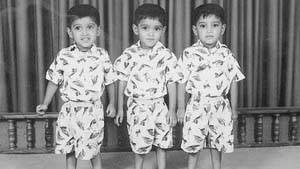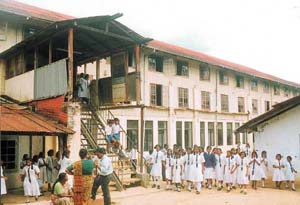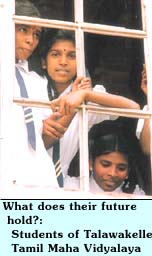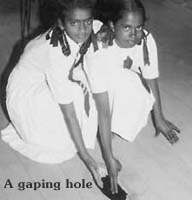 |
 13th December 1998 |
Front Page| |
 Of twos, threes, and more |
Contents
|
|
 |
A school?By Renuka Sadanandan and Tharuka Dissanaike
What then are the children doing here?
This is not a well-kept factory, nor one that has been renovated to be a showpiece. Coats of paint and sundry repairs are obviously unheard of. Up the ramshackle steps, the first and second floors reveal cracked floorboards, broken windows and even more shocking, no partitions between classes. Classes of 20 to 30 students sit side by side separated by just a few feet and teachers are left the unenviable task of keeping their students' attention, not to mention maintaining discipline whilst another subject, another lesson is taught within earshot. "It is a difficult situation," concedes Teachers' Union President T Naguleswaran, who has been at the school the past 10 years, teaching mathematics. "In 1995, the Education Department built us a new block of classrooms which now house the Year 11 classes and also gave us a mini science laboratory, but that apart, conditions in the factory are not conducive to learning." They have no proper desks, only bare basic tables, benches and the heat and rain to contend with when the weather turns fickle. Of the 71 teaching posts, only 41 are filled. A tough situation for a school which has classes from Year One upto Advanced Level Mathematics and Bio Science. Yet this is no lackadaisical bunch of students, discouraged by their lack of facilities. For the bubbly girls of Year 10 B, whom we met, ambitions are aplenty. They crowd around and once their initial shyness is overcome, discuss their aspirations and dreams of higher education. They all want to go to university and become doctors and engineers. Any problems? "Not enough laboratory facilities and not enough science teachers," they chorus.
S. Navin, 15, comes to school from Lindula, six kilometers away. His favourite subject is Math and teachers look upon him as a sure future engineer. Navin complained of the lack of laboratory facilities. "A place to play Cricket," a friend piped in. At present the students use a clearing by the Kotmale Oya to play. "When we bat, the ball goes into the water." "We also need good toilets," Navin said. The students use ramshackle and badly put together toilets behind the crumbling factory. The school has two classes from Year 1to 5, and four classes per grade for Year 6 to 10 and three separate classes in Year 11. It is one of the few 1AB cluster schools in the central province. P. Deenathayalan an old student himself, is the school's English teacher and vouches for its high standard of education. "Last year two students entered engineering Faculty and Four entered medical Faculty," he says. Deenathayalan's father had been an employee when the Middleton factory was functional. He said it was originally a coffee and then a tea factory. Now Middleton is a part of Logie Estate and leaf is sent to the Logie factory for processing. For Agriculture Science teacher Mr Mailu, also a past student, the desire to see better conditions here is all the more urgent as his two children, a daughter and son are both students of the school in Year 5 and 2 respectively. The teachers feel strongly that the school's status is affected by the conditions they are forced to work under. In the past they had as many as 1,800 students on roll, but this number has dropped with many parents in the area being reluctant to send them to the 'factory'. They point to other drawbacks, like the lack of toilets for both staff and students, an inadequate library and the lack of a school hall for a school of this size. Support for the school has come from Rural Industrial Development Minister S Thondaman, who declared open the new block of classrooms. He has also donated sports equipment. CIDA, the Canadian aid agency also provides some funding. What of the future? Doubts surface daily as they see the gushing waters of the Kotmale Oya that flows alongside the school. School authorities have been told that when the Upper Kotmale Project is commissioned, the school/factory will be flooded. Some feel that this would not be too bad an option. After all they will then have to move to a better location. Hopefully, not another tea factory.
Front Page| News/Comment| Editorial/Opinion| Business| Sports | Mirror Magazine |
|
 |
Please send your comments and suggestions on this web site to |
|
 At
first glance, it seems just another school scene, one you would glimpse
in any town or village around noon. White clad children streaming out of
class, eager for their break. But take a closer look, amidst the chatter
and the laughter. Can this be a school? Isn't it a tea factory?
At
first glance, it seems just another school scene, one you would glimpse
in any town or village around noon. White clad children streaming out of
class, eager for their break. But take a closer look, amidst the chatter
and the laughter. Can this be a school? Isn't it a tea factory?  For
1,400 children in Talawakelle, school is a tea factory. An ancient disused
coffee/tea factory belonging to the Middleton Estate became the Talawakelle
Tamil Maha Vidyalaya in 1979 and since then with few improvements has been
their seat of learning.
For
1,400 children in Talawakelle, school is a tea factory. An ancient disused
coffee/tea factory belonging to the Middleton Estate became the Talawakelle
Tamil Maha Vidyalaya in 1979 and since then with few improvements has been
their seat of learning. "Too
much noise," volunteers S.Kannagi, a confident pigtailed 16 -year-old
who will sit her O'Levels next year. The more bashful, S.Vijayasunderi
says that the roof leaks when it rains, as it often does in these cool
climes. "And at other times, dust falls from the ceiling." The
girls also have a rather delicate problem. Gaping cracks in the floorboards
make their lives uncomfortable, for anyone looking up from the lower floors
can see them clearly through the cracks. A very practical problem in a
mixed school. 'Can't the boys take the upper floor and the girls, the lower
floor to avoid such embarrassment?' 'No, no,' they giggle, 'these are mixed
classes.'
"Too
much noise," volunteers S.Kannagi, a confident pigtailed 16 -year-old
who will sit her O'Levels next year. The more bashful, S.Vijayasunderi
says that the roof leaks when it rains, as it often does in these cool
climes. "And at other times, dust falls from the ceiling." The
girls also have a rather delicate problem. Gaping cracks in the floorboards
make their lives uncomfortable, for anyone looking up from the lower floors
can see them clearly through the cracks. A very practical problem in a
mixed school. 'Can't the boys take the upper floor and the girls, the lower
floor to avoid such embarrassment?' 'No, no,' they giggle, 'these are mixed
classes.'